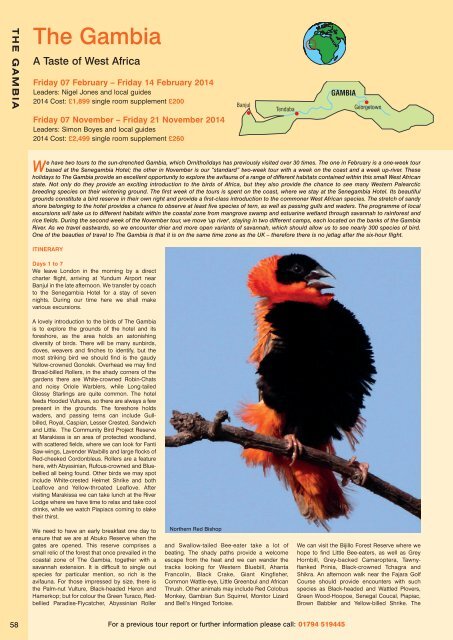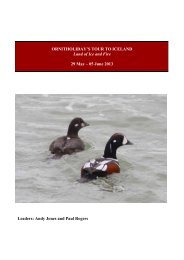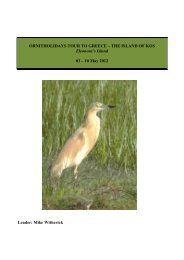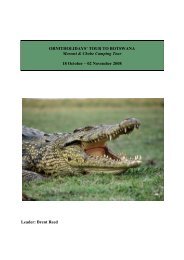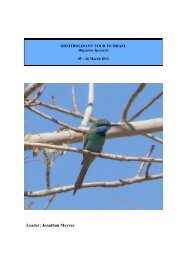Download 2014 Brochure (.pdf) - Ornitholidays
Download 2014 Brochure (.pdf) - Ornitholidays
Download 2014 Brochure (.pdf) - Ornitholidays
You also want an ePaper? Increase the reach of your titles
YUMPU automatically turns print PDFs into web optimized ePapers that Google loves.
T H E G A M B I A<br />
The Gambia<br />
A Taste of West Africa<br />
Friday 07 February – Friday 14 February <strong>2014</strong><br />
Leaders: Nigel Jones and local guides<br />
<strong>2014</strong> Cost: £1,899 single room supplement £200<br />
Friday 07 November – Friday 21 November <strong>2014</strong><br />
Leaders: Simon Boyes and local guides<br />
<strong>2014</strong> Cost: £2,499 single room supplement £260<br />
Banjul<br />
Tendaba<br />
GAMBIA<br />
Georgetown<br />
e have two tours to the sun-drenched Gambia, which <strong>Ornitholidays</strong> has previously visited over 30 times. The one in February is a one-week tour<br />
Wbased at the Senegambia Hotel; the other in November is our “standard” two-week tour with a week on the coast and a week up-river. These<br />
holidays to The Gambia provide an excellent opportunity to explore the avifauna of a range of different habitats contained within this small West African<br />
state. Not only do they provide an exciting introduction to the birds of Africa, but they also provide the chance to see many Western Palearctic<br />
breeding species on their wintering ground. The first week of the tours is spent on the coast, where we stay at the Senegambia Hotel. Its beautiful<br />
grounds constitute a bird reserve in their own right and provide a first-class introduction to the commoner West African species. The stretch of sandy<br />
shore belonging to the hotel provides a chance to observe at least five species of tern, as well as passing gulls and waders. The programme of local<br />
excursions will take us to different habitats within the coastal zone from mangrove swamp and estuarine wetland through savannah to rainforest and<br />
rice fields. During the second week of the November tour, we move 'up river', staying in two different camps, each located on the banks of the Gambia<br />
River. As we travel eastwards, so we encounter drier and more open variants of savannah, which should allow us to see nearly 300 species of bird.<br />
One of the beauties of travel to The Gambia is that it is on the same time zone as the UK – therefore there is no jetlag after the six-hour flight.<br />
ITINERARY<br />
Days 1 to 7<br />
We leave London in the morning by a direct<br />
charter flight, arriving at Yundum Airport near<br />
Banjul in the late afternoon. We transfer by coach<br />
to the Senegambia Hotel for a stay of seven<br />
nights. During our time here we shall make<br />
various excursions.<br />
A lovely introduction to the birds of The Gambia<br />
is to explore the grounds of the hotel and its<br />
foreshore, as the area holds an astonishing<br />
diversity of birds. There will be many sunbirds,<br />
doves, weavers and finches to identify, but the<br />
most striking bird we should find is the gaudy<br />
Yellow-crowned Gonolek. Overhead we may find<br />
Broad-billed Rollers, in the shady corners of the<br />
gardens there are White-crowned Robin-Chats<br />
and noisy Oriole Warblers, while Long-tailed<br />
Glossy Starlings are quite common. The hotel<br />
feeds Hooded Vultures, so there are always a few<br />
present in the grounds. The foreshore holds<br />
waders, and passing terns can include Gullbilled,<br />
Royal, Caspian, Lesser Crested, Sandwich<br />
and Little. The Community Bird Project Reserve<br />
at Marakissa is an area of protected woodland,<br />
with scattered fields, where we can look for Fanti<br />
Saw-wings, Lavender Waxbills and large flocks of<br />
Red-cheeked Cordonbleus. Rollers are a feature<br />
here, with Abyssinian, Rufous-crowned and Bluebellied<br />
all being found. Other birds we may spot<br />
include White-crested Helmet Shrike and both<br />
Leaflove and Yellow-throated Leaflove. After<br />
visiting Marakissa we can take lunch at the River<br />
Lodge where we have time to relax and take cool<br />
drinks, while we watch Piapiacs coming to slake<br />
their thirst.<br />
We need to have an early breakfast one day to<br />
ensure that we are at Abuko Reserve when the<br />
gates are opened. This reserve comprises a<br />
small relic of the forest that once prevailed in the<br />
coastal zone of The Gambia, together with a<br />
savannah extension. It is difficult to single out<br />
species for particular mention, so rich is the<br />
avifauna. For those impressed by size, there is<br />
the Palm-nut Vulture, Black-headed Heron and<br />
Hamerkop; but for colour the Green Turaco, Redbellied<br />
Paradise-Flycatcher, Abyssinian Roller<br />
Northern Red Bishop<br />
and Swallow-tailed Bee-eater take a lot of<br />
beating. The shady paths provide a welcome<br />
escape from the heat and we can wander the<br />
tracks looking for Western Bluebill, Ahanta<br />
Francolin, Black Crake, Giant Kingfisher,<br />
Common Wattle-eye, Little Greenbul and African<br />
Thrush. Other animals may include Red Colobus<br />
Monkey, Gambian Sun Squirrel, Monitor Lizard<br />
and Bell’s Hinged Tortoise.<br />
We can visit the Bijillo Forest Reserve where we<br />
hope to find Little Bee-eaters, as well as Grey<br />
Hornbill, Grey-backed Camaroptera, Tawnyflanked<br />
Prinia, Black-crowned Tchagra and<br />
Shikra. An afternoon walk near the Fajara Golf<br />
Course should provide encounters with such<br />
species as Black-headed and Wattled Plovers,<br />
Green Wood-Hoopoe, Senegal Coucal, Piapiac,<br />
Brown Babbler and Yellow-billed Shrike. The<br />
58<br />
For a previous tour report or further information please call: 01794 519445


